Labour Management Relations in Singapore: A Competitive Edge
VerifiedAdded on 2023/06/15
|14
|2878
|274
Report
AI Summary
This report provides an analysis of labour management relations (LMR) in Singapore, focusing on the roles of employers, employees, trade unions, and the government. It examines how these key players contribute to Singapore's competitive advantage through initiatives such as attracting investors, improving workplace benefits, and actively listening to employees. The report highlights the tripartite relationship between the government, employers, and labor movement, and how this connection fosters economic success and social progress. Examples of competitive advantages, such as employment growth during economic crises and high rankings in global competitiveness reports, are discussed. The report concludes by emphasizing the ongoing efforts to address challenges and improve the LMR landscape in Singapore.
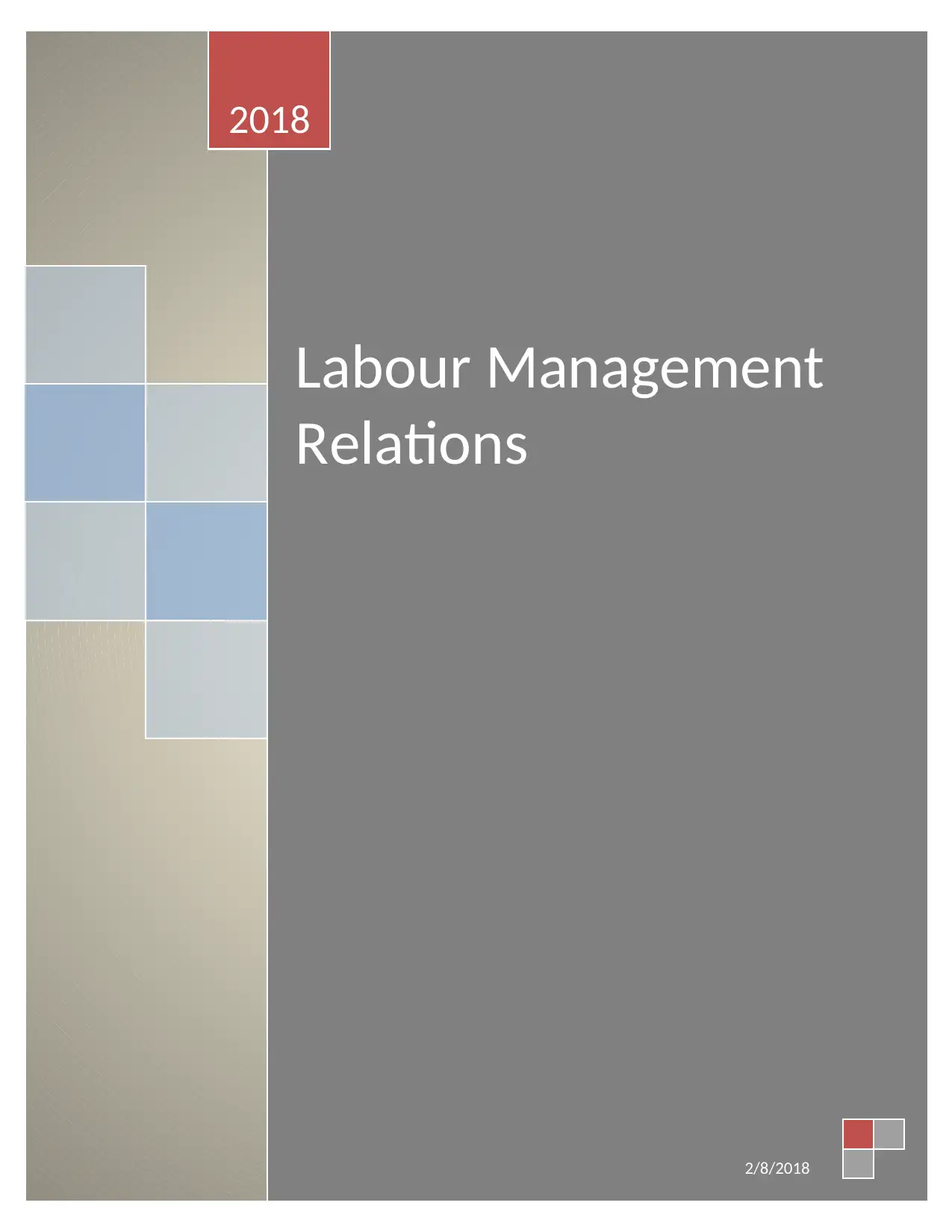
Labour Management
Relations
2018
2/8/2018
Relations
2018
2/8/2018
Paraphrase This Document
Need a fresh take? Get an instant paraphrase of this document with our AI Paraphraser

Labour Management Relations 1
Contents
Introduction......................................................................................................................................2
Analysis of the roles of 4 key players of LMR................................................................................3
Employers....................................................................................................................................3
Employees....................................................................................................................................3
Trade union..................................................................................................................................4
Government.................................................................................................................................6
Analysis of competitive advantage to Singapore through LMR.....................................................6
Invitation to investors..................................................................................................................6
Workplace benefits......................................................................................................................7
Listening to employees................................................................................................................8
Conclusion.....................................................................................................................................10
Bibliography..................................................................................................................................11
Contents
Introduction......................................................................................................................................2
Analysis of the roles of 4 key players of LMR................................................................................3
Employers....................................................................................................................................3
Employees....................................................................................................................................3
Trade union..................................................................................................................................4
Government.................................................................................................................................6
Analysis of competitive advantage to Singapore through LMR.....................................................6
Invitation to investors..................................................................................................................6
Workplace benefits......................................................................................................................7
Listening to employees................................................................................................................8
Conclusion.....................................................................................................................................10
Bibliography..................................................................................................................................11
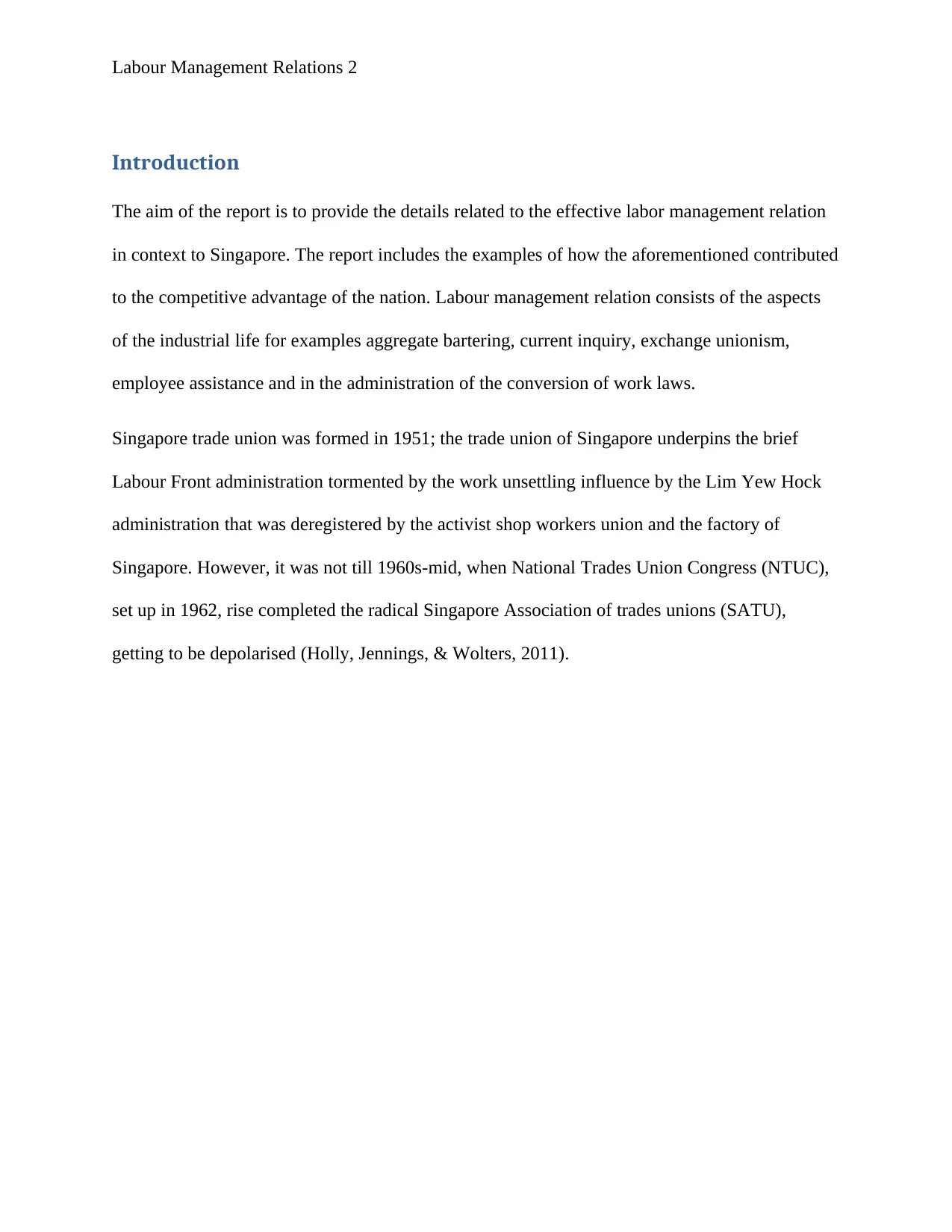
Labour Management Relations 2
Introduction
The aim of the report is to provide the details related to the effective labor management relation
in context to Singapore. The report includes the examples of how the aforementioned contributed
to the competitive advantage of the nation. Labour management relation consists of the aspects
of the industrial life for examples aggregate bartering, current inquiry, exchange unionism,
employee assistance and in the administration of the conversion of work laws.
Singapore trade union was formed in 1951; the trade union of Singapore underpins the brief
Labour Front administration tormented by the work unsettling influence by the Lim Yew Hock
administration that was deregistered by the activist shop workers union and the factory of
Singapore. However, it was not till 1960s-mid, when National Trades Union Congress (NTUC),
set up in 1962, rise completed the radical Singapore Association of trades unions (SATU),
getting to be depolarised (Holly, Jennings, & Wolters, 2011).
Introduction
The aim of the report is to provide the details related to the effective labor management relation
in context to Singapore. The report includes the examples of how the aforementioned contributed
to the competitive advantage of the nation. Labour management relation consists of the aspects
of the industrial life for examples aggregate bartering, current inquiry, exchange unionism,
employee assistance and in the administration of the conversion of work laws.
Singapore trade union was formed in 1951; the trade union of Singapore underpins the brief
Labour Front administration tormented by the work unsettling influence by the Lim Yew Hock
administration that was deregistered by the activist shop workers union and the factory of
Singapore. However, it was not till 1960s-mid, when National Trades Union Congress (NTUC),
set up in 1962, rise completed the radical Singapore Association of trades unions (SATU),
getting to be depolarised (Holly, Jennings, & Wolters, 2011).
⊘ This is a preview!⊘
Do you want full access?
Subscribe today to unlock all pages.

Trusted by 1+ million students worldwide
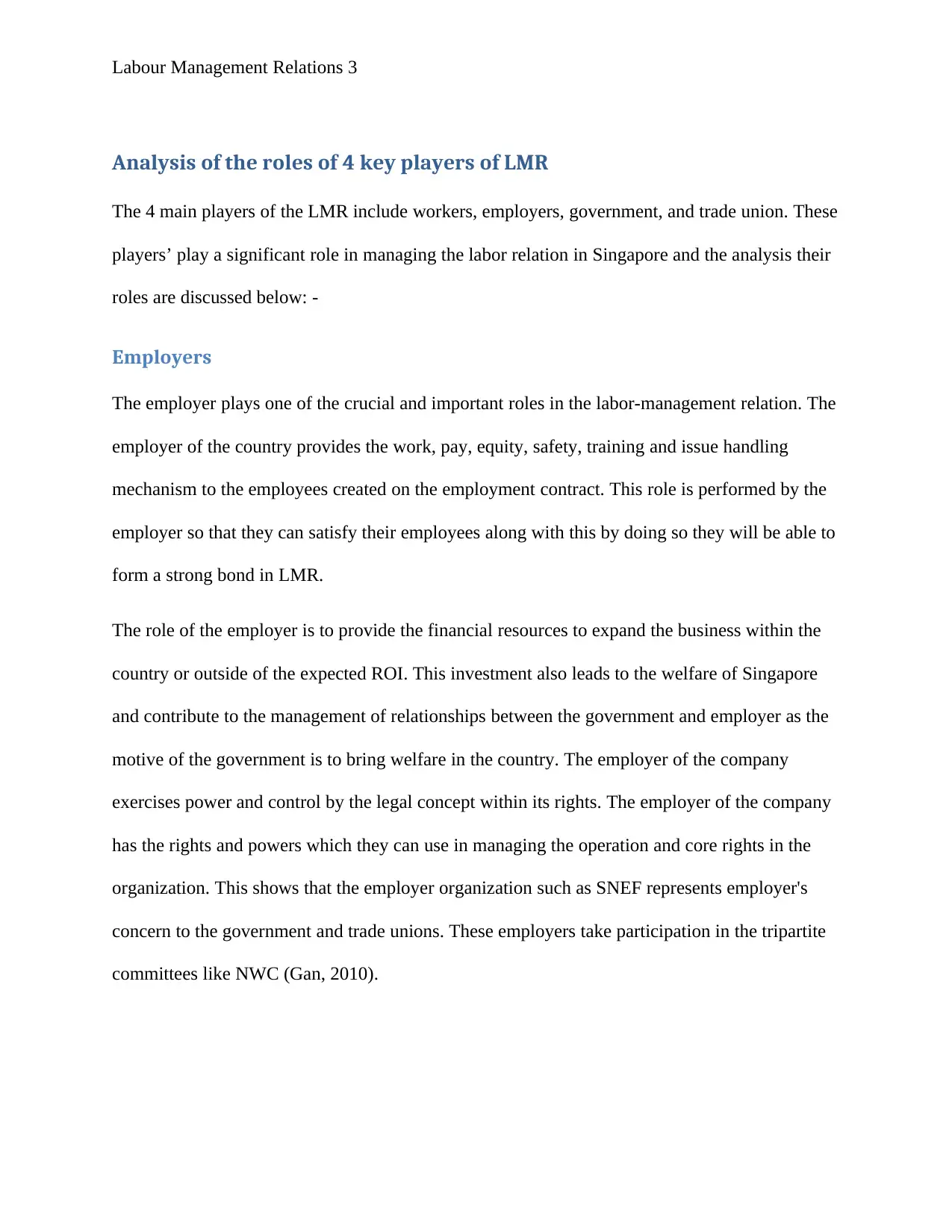
Labour Management Relations 3
Analysis of the roles of 4 key players of LMR
The 4 main players of the LMR include workers, employers, government, and trade union. These
players’ play a significant role in managing the labor relation in Singapore and the analysis their
roles are discussed below: -
Employers
The employer plays one of the crucial and important roles in the labor-management relation. The
employer of the country provides the work, pay, equity, safety, training and issue handling
mechanism to the employees created on the employment contract. This role is performed by the
employer so that they can satisfy their employees along with this by doing so they will be able to
form a strong bond in LMR.
The role of the employer is to provide the financial resources to expand the business within the
country or outside of the expected ROI. This investment also leads to the welfare of Singapore
and contribute to the management of relationships between the government and employer as the
motive of the government is to bring welfare in the country. The employer of the company
exercises power and control by the legal concept within its rights. The employer of the company
has the rights and powers which they can use in managing the operation and core rights in the
organization. This shows that the employer organization such as SNEF represents employer's
concern to the government and trade unions. These employers take participation in the tripartite
committees like NWC (Gan, 2010).
Analysis of the roles of 4 key players of LMR
The 4 main players of the LMR include workers, employers, government, and trade union. These
players’ play a significant role in managing the labor relation in Singapore and the analysis their
roles are discussed below: -
Employers
The employer plays one of the crucial and important roles in the labor-management relation. The
employer of the country provides the work, pay, equity, safety, training and issue handling
mechanism to the employees created on the employment contract. This role is performed by the
employer so that they can satisfy their employees along with this by doing so they will be able to
form a strong bond in LMR.
The role of the employer is to provide the financial resources to expand the business within the
country or outside of the expected ROI. This investment also leads to the welfare of Singapore
and contribute to the management of relationships between the government and employer as the
motive of the government is to bring welfare in the country. The employer of the company
exercises power and control by the legal concept within its rights. The employer of the company
has the rights and powers which they can use in managing the operation and core rights in the
organization. This shows that the employer organization such as SNEF represents employer's
concern to the government and trade unions. These employers take participation in the tripartite
committees like NWC (Gan, 2010).
Paraphrase This Document
Need a fresh take? Get an instant paraphrase of this document with our AI Paraphraser
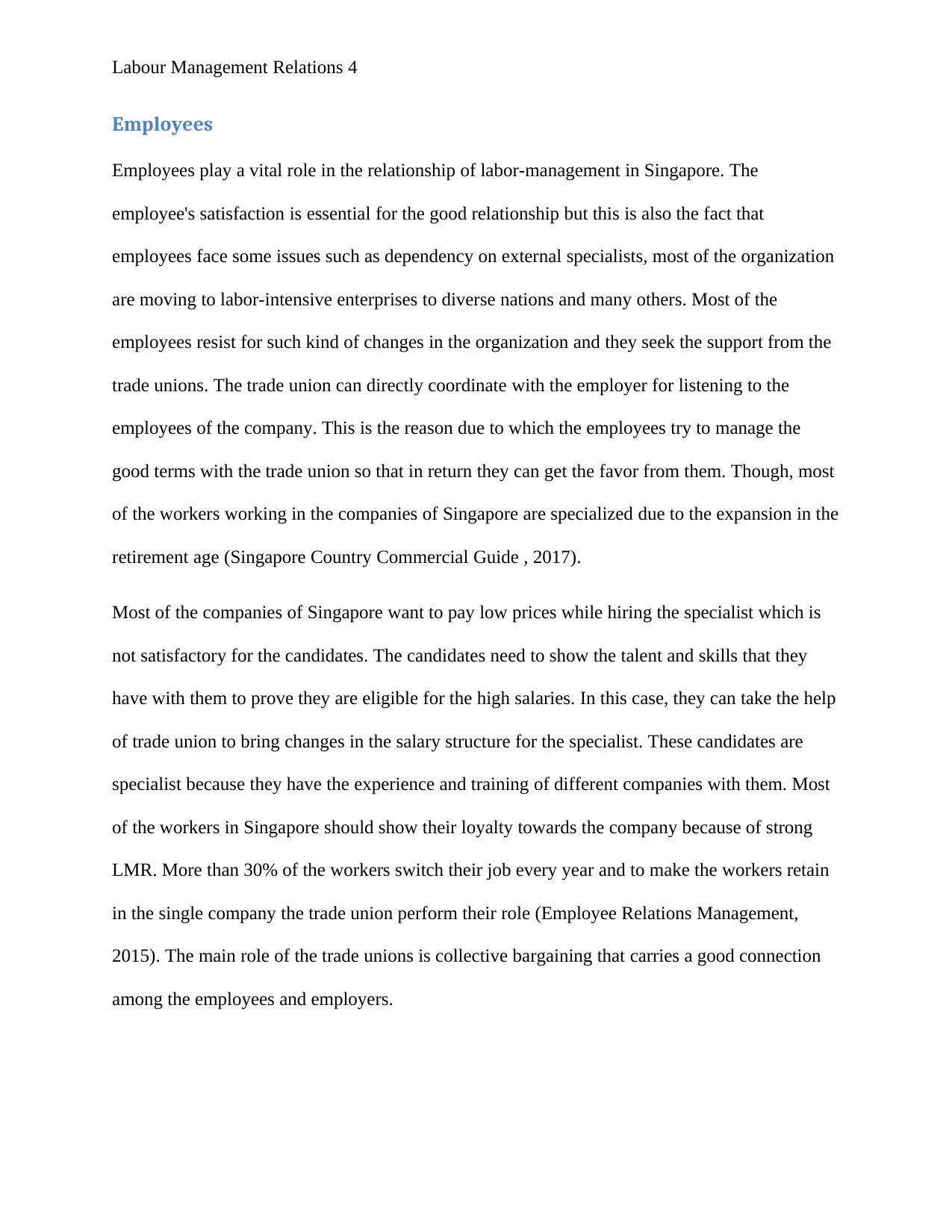
Labour Management Relations 4
Employees
Employees play a vital role in the relationship of labor-management in Singapore. The
employee's satisfaction is essential for the good relationship but this is also the fact that
employees face some issues such as dependency on external specialists, most of the organization
are moving to labor-intensive enterprises to diverse nations and many others. Most of the
employees resist for such kind of changes in the organization and they seek the support from the
trade unions. The trade union can directly coordinate with the employer for listening to the
employees of the company. This is the reason due to which the employees try to manage the
good terms with the trade union so that in return they can get the favor from them. Though, most
of the workers working in the companies of Singapore are specialized due to the expansion in the
retirement age (Singapore Country Commercial Guide , 2017).
Most of the companies of Singapore want to pay low prices while hiring the specialist which is
not satisfactory for the candidates. The candidates need to show the talent and skills that they
have with them to prove they are eligible for the high salaries. In this case, they can take the help
of trade union to bring changes in the salary structure for the specialist. These candidates are
specialist because they have the experience and training of different companies with them. Most
of the workers in Singapore should show their loyalty towards the company because of strong
LMR. More than 30% of the workers switch their job every year and to make the workers retain
in the single company the trade union perform their role (Employee Relations Management,
2015). The main role of the trade unions is collective bargaining that carries a good connection
among the employees and employers.
Employees
Employees play a vital role in the relationship of labor-management in Singapore. The
employee's satisfaction is essential for the good relationship but this is also the fact that
employees face some issues such as dependency on external specialists, most of the organization
are moving to labor-intensive enterprises to diverse nations and many others. Most of the
employees resist for such kind of changes in the organization and they seek the support from the
trade unions. The trade union can directly coordinate with the employer for listening to the
employees of the company. This is the reason due to which the employees try to manage the
good terms with the trade union so that in return they can get the favor from them. Though, most
of the workers working in the companies of Singapore are specialized due to the expansion in the
retirement age (Singapore Country Commercial Guide , 2017).
Most of the companies of Singapore want to pay low prices while hiring the specialist which is
not satisfactory for the candidates. The candidates need to show the talent and skills that they
have with them to prove they are eligible for the high salaries. In this case, they can take the help
of trade union to bring changes in the salary structure for the specialist. These candidates are
specialist because they have the experience and training of different companies with them. Most
of the workers in Singapore should show their loyalty towards the company because of strong
LMR. More than 30% of the workers switch their job every year and to make the workers retain
in the single company the trade union perform their role (Employee Relations Management,
2015). The main role of the trade unions is collective bargaining that carries a good connection
among the employees and employers.
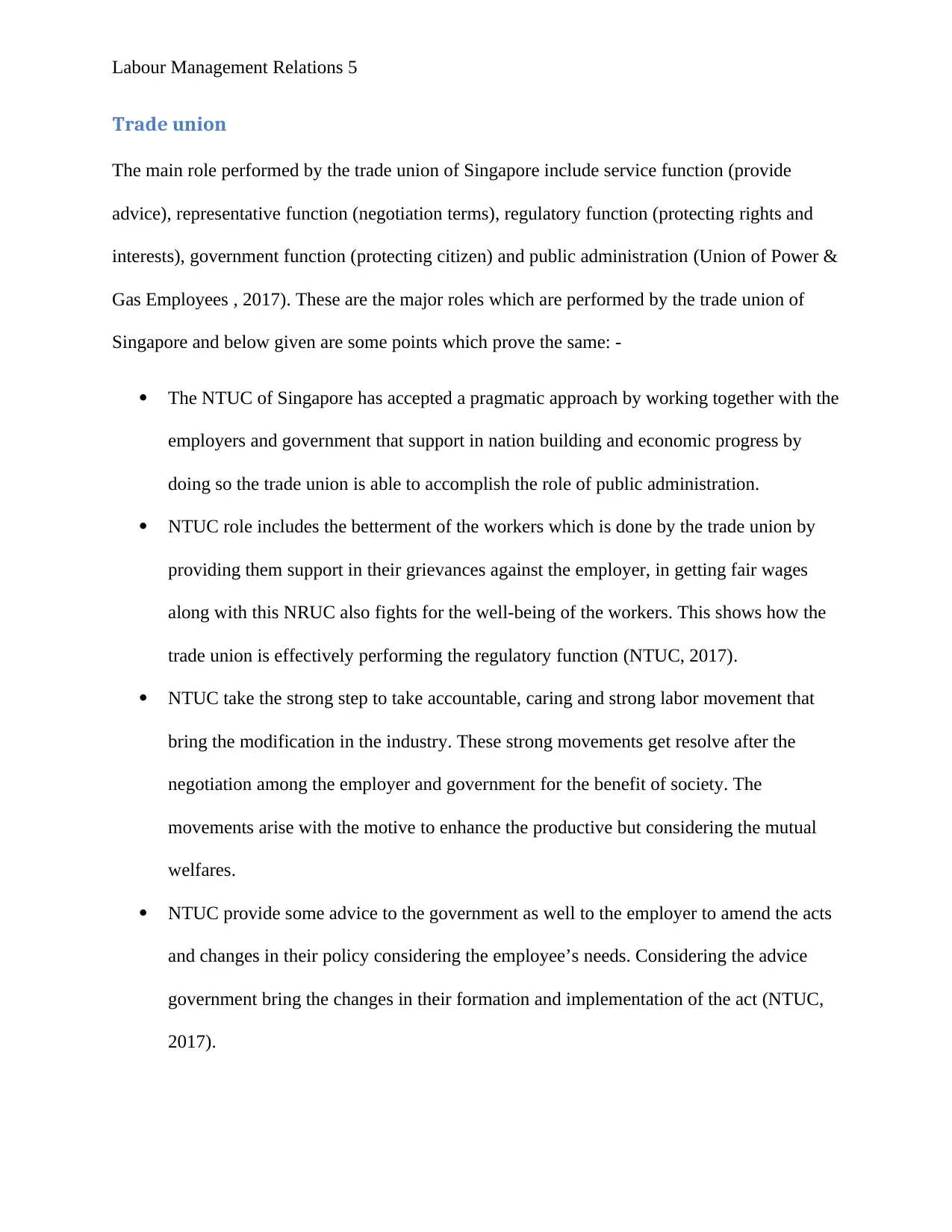
Labour Management Relations 5
Trade union
The main role performed by the trade union of Singapore include service function (provide
advice), representative function (negotiation terms), regulatory function (protecting rights and
interests), government function (protecting citizen) and public administration (Union of Power &
Gas Employees , 2017). These are the major roles which are performed by the trade union of
Singapore and below given are some points which prove the same: -
The NTUC of Singapore has accepted a pragmatic approach by working together with the
employers and government that support in nation building and economic progress by
doing so the trade union is able to accomplish the role of public administration.
NTUC role includes the betterment of the workers which is done by the trade union by
providing them support in their grievances against the employer, in getting fair wages
along with this NRUC also fights for the well-being of the workers. This shows how the
trade union is effectively performing the regulatory function (NTUC, 2017).
NTUC take the strong step to take accountable, caring and strong labor movement that
bring the modification in the industry. These strong movements get resolve after the
negotiation among the employer and government for the benefit of society. The
movements arise with the motive to enhance the productive but considering the mutual
welfares.
NTUC provide some advice to the government as well to the employer to amend the acts
and changes in their policy considering the employee’s needs. Considering the advice
government bring the changes in their formation and implementation of the act (NTUC,
2017).
Trade union
The main role performed by the trade union of Singapore include service function (provide
advice), representative function (negotiation terms), regulatory function (protecting rights and
interests), government function (protecting citizen) and public administration (Union of Power &
Gas Employees , 2017). These are the major roles which are performed by the trade union of
Singapore and below given are some points which prove the same: -
The NTUC of Singapore has accepted a pragmatic approach by working together with the
employers and government that support in nation building and economic progress by
doing so the trade union is able to accomplish the role of public administration.
NTUC role includes the betterment of the workers which is done by the trade union by
providing them support in their grievances against the employer, in getting fair wages
along with this NRUC also fights for the well-being of the workers. This shows how the
trade union is effectively performing the regulatory function (NTUC, 2017).
NTUC take the strong step to take accountable, caring and strong labor movement that
bring the modification in the industry. These strong movements get resolve after the
negotiation among the employer and government for the benefit of society. The
movements arise with the motive to enhance the productive but considering the mutual
welfares.
NTUC provide some advice to the government as well to the employer to amend the acts
and changes in their policy considering the employee’s needs. Considering the advice
government bring the changes in their formation and implementation of the act (NTUC,
2017).
⊘ This is a preview!⊘
Do you want full access?
Subscribe today to unlock all pages.

Trusted by 1+ million students worldwide

Labour Management Relations 6
NTUC communicate about the decisions to employees after performing the role of
negotiation with the employers and government. They try to make the employee
understand that why they formed this decision (Ministry of Manpower, 2017).
Government
Government performs the role of the custodian of the worker and the financial organizer along
with this the role of the government is to amend the acts for the betterment of the nation
(Ministry of Manpower, 2017). The government of Singapore introduced act such as Trade
Disputes Act and Criminal Law TP Act. The criminal law (Temporary provision) Act is a
Singapore statue that came into existence in the year 1955. This act was formed with the
objective to keep the public safety, peace and the good order of Singapore (Ministry of Home
Affairs, 2018). Under this act, if the ministry for home affairs is pleased that any person has been
related with the actions of the criminal nature then the ministry detain the person for any period
not more than 12 months from the date of the order (Chu, Daffern, Thomas, Yaming, Long, &
O'Brien, 2015). There are certain strict guidelines in order to use the powers that are included in
CL (TP) act which is essential to be followed by the company.
Analysis of competitive advantage to Singapore through LMR
The industrial relations of Singapore are considered by the tripartite relationship among the
government, employers and the labor movement. This connection plays a vital role in forming
the competitive advantage to Singapore. Some of the competitive advantages are discussed
below: -
NTUC communicate about the decisions to employees after performing the role of
negotiation with the employers and government. They try to make the employee
understand that why they formed this decision (Ministry of Manpower, 2017).
Government
Government performs the role of the custodian of the worker and the financial organizer along
with this the role of the government is to amend the acts for the betterment of the nation
(Ministry of Manpower, 2017). The government of Singapore introduced act such as Trade
Disputes Act and Criminal Law TP Act. The criminal law (Temporary provision) Act is a
Singapore statue that came into existence in the year 1955. This act was formed with the
objective to keep the public safety, peace and the good order of Singapore (Ministry of Home
Affairs, 2018). Under this act, if the ministry for home affairs is pleased that any person has been
related with the actions of the criminal nature then the ministry detain the person for any period
not more than 12 months from the date of the order (Chu, Daffern, Thomas, Yaming, Long, &
O'Brien, 2015). There are certain strict guidelines in order to use the powers that are included in
CL (TP) act which is essential to be followed by the company.
Analysis of competitive advantage to Singapore through LMR
The industrial relations of Singapore are considered by the tripartite relationship among the
government, employers and the labor movement. This connection plays a vital role in forming
the competitive advantage to Singapore. Some of the competitive advantages are discussed
below: -
Paraphrase This Document
Need a fresh take? Get an instant paraphrase of this document with our AI Paraphraser
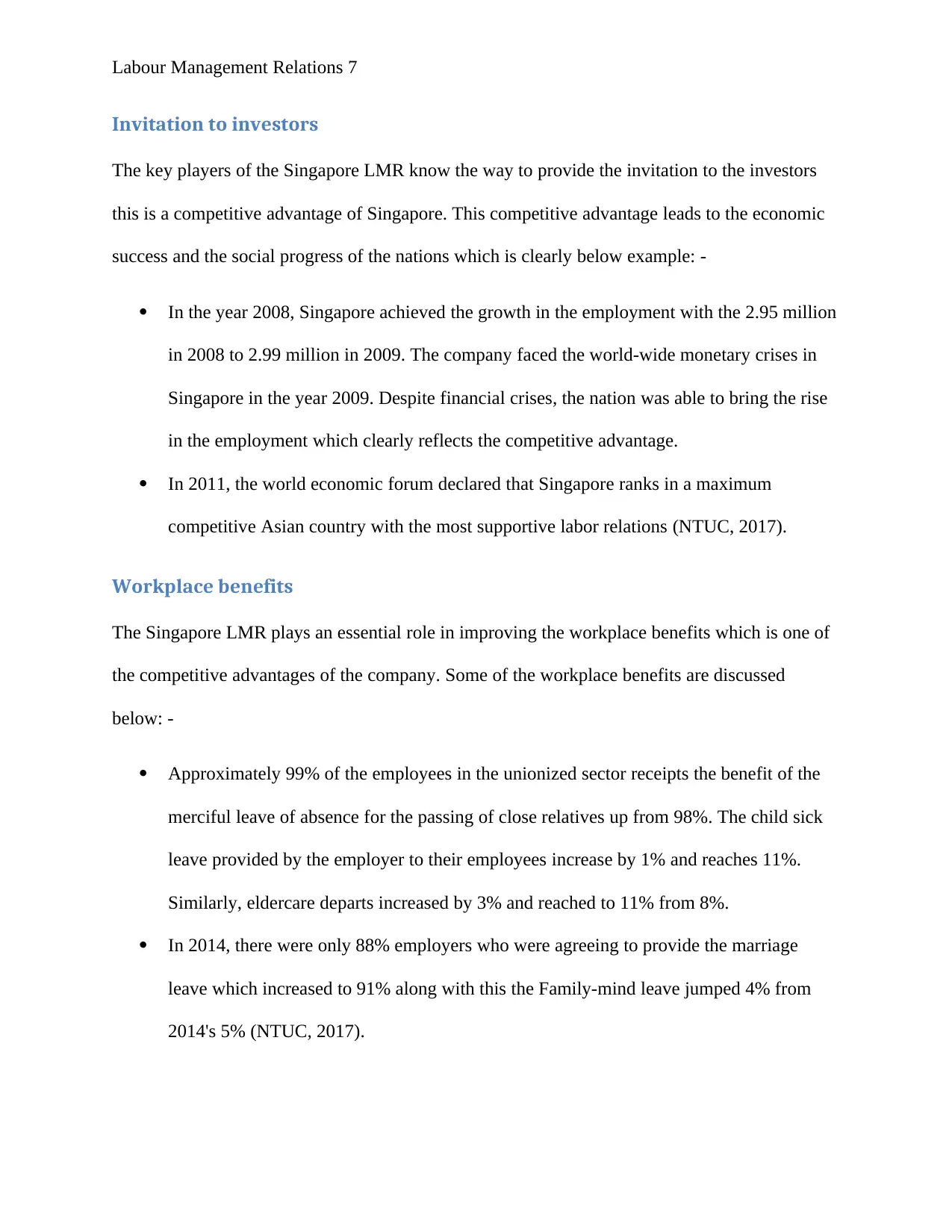
Labour Management Relations 7
Invitation to investors
The key players of the Singapore LMR know the way to provide the invitation to the investors
this is a competitive advantage of Singapore. This competitive advantage leads to the economic
success and the social progress of the nations which is clearly below example: -
In the year 2008, Singapore achieved the growth in the employment with the 2.95 million
in 2008 to 2.99 million in 2009. The company faced the world-wide monetary crises in
Singapore in the year 2009. Despite financial crises, the nation was able to bring the rise
in the employment which clearly reflects the competitive advantage.
In 2011, the world economic forum declared that Singapore ranks in a maximum
competitive Asian country with the most supportive labor relations (NTUC, 2017).
Workplace benefits
The Singapore LMR plays an essential role in improving the workplace benefits which is one of
the competitive advantages of the company. Some of the workplace benefits are discussed
below: -
Approximately 99% of the employees in the unionized sector receipts the benefit of the
merciful leave of absence for the passing of close relatives up from 98%. The child sick
leave provided by the employer to their employees increase by 1% and reaches 11%.
Similarly, eldercare departs increased by 3% and reached to 11% from 8%.
In 2014, there were only 88% employers who were agreeing to provide the marriage
leave which increased to 91% along with this the Family-mind leave jumped 4% from
2014's 5% (NTUC, 2017).
Invitation to investors
The key players of the Singapore LMR know the way to provide the invitation to the investors
this is a competitive advantage of Singapore. This competitive advantage leads to the economic
success and the social progress of the nations which is clearly below example: -
In the year 2008, Singapore achieved the growth in the employment with the 2.95 million
in 2008 to 2.99 million in 2009. The company faced the world-wide monetary crises in
Singapore in the year 2009. Despite financial crises, the nation was able to bring the rise
in the employment which clearly reflects the competitive advantage.
In 2011, the world economic forum declared that Singapore ranks in a maximum
competitive Asian country with the most supportive labor relations (NTUC, 2017).
Workplace benefits
The Singapore LMR plays an essential role in improving the workplace benefits which is one of
the competitive advantages of the company. Some of the workplace benefits are discussed
below: -
Approximately 99% of the employees in the unionized sector receipts the benefit of the
merciful leave of absence for the passing of close relatives up from 98%. The child sick
leave provided by the employer to their employees increase by 1% and reaches 11%.
Similarly, eldercare departs increased by 3% and reached to 11% from 8%.
In 2014, there were only 88% employers who were agreeing to provide the marriage
leave which increased to 91% along with this the Family-mind leave jumped 4% from
2014's 5% (NTUC, 2017).
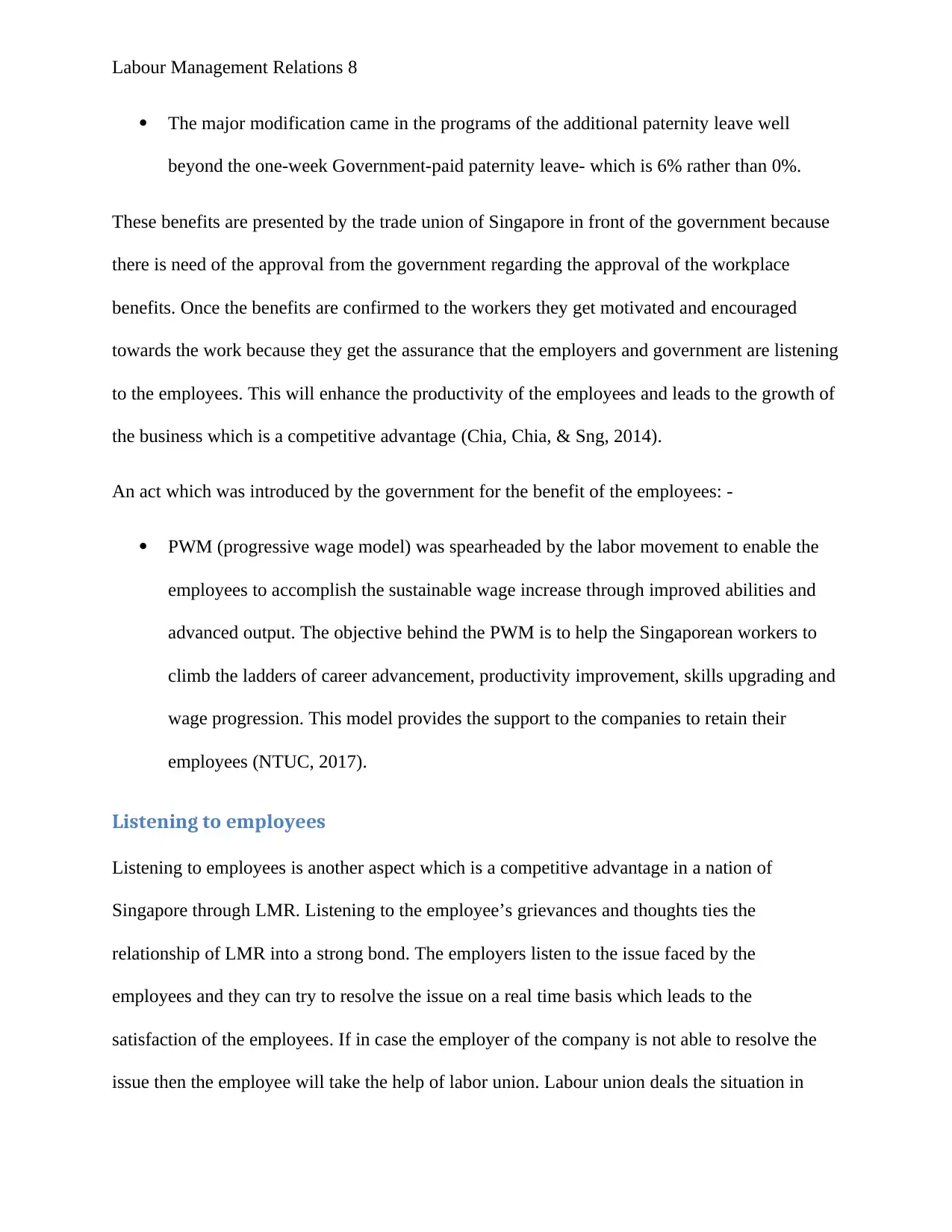
Labour Management Relations 8
The major modification came in the programs of the additional paternity leave well
beyond the one-week Government-paid paternity leave- which is 6% rather than 0%.
These benefits are presented by the trade union of Singapore in front of the government because
there is need of the approval from the government regarding the approval of the workplace
benefits. Once the benefits are confirmed to the workers they get motivated and encouraged
towards the work because they get the assurance that the employers and government are listening
to the employees. This will enhance the productivity of the employees and leads to the growth of
the business which is a competitive advantage (Chia, Chia, & Sng, 2014).
An act which was introduced by the government for the benefit of the employees: -
PWM (progressive wage model) was spearheaded by the labor movement to enable the
employees to accomplish the sustainable wage increase through improved abilities and
advanced output. The objective behind the PWM is to help the Singaporean workers to
climb the ladders of career advancement, productivity improvement, skills upgrading and
wage progression. This model provides the support to the companies to retain their
employees (NTUC, 2017).
Listening to employees
Listening to employees is another aspect which is a competitive advantage in a nation of
Singapore through LMR. Listening to the employee’s grievances and thoughts ties the
relationship of LMR into a strong bond. The employers listen to the issue faced by the
employees and they can try to resolve the issue on a real time basis which leads to the
satisfaction of the employees. If in case the employer of the company is not able to resolve the
issue then the employee will take the help of labor union. Labour union deals the situation in
The major modification came in the programs of the additional paternity leave well
beyond the one-week Government-paid paternity leave- which is 6% rather than 0%.
These benefits are presented by the trade union of Singapore in front of the government because
there is need of the approval from the government regarding the approval of the workplace
benefits. Once the benefits are confirmed to the workers they get motivated and encouraged
towards the work because they get the assurance that the employers and government are listening
to the employees. This will enhance the productivity of the employees and leads to the growth of
the business which is a competitive advantage (Chia, Chia, & Sng, 2014).
An act which was introduced by the government for the benefit of the employees: -
PWM (progressive wage model) was spearheaded by the labor movement to enable the
employees to accomplish the sustainable wage increase through improved abilities and
advanced output. The objective behind the PWM is to help the Singaporean workers to
climb the ladders of career advancement, productivity improvement, skills upgrading and
wage progression. This model provides the support to the companies to retain their
employees (NTUC, 2017).
Listening to employees
Listening to employees is another aspect which is a competitive advantage in a nation of
Singapore through LMR. Listening to the employee’s grievances and thoughts ties the
relationship of LMR into a strong bond. The employers listen to the issue faced by the
employees and they can try to resolve the issue on a real time basis which leads to the
satisfaction of the employees. If in case the employer of the company is not able to resolve the
issue then the employee will take the help of labor union. Labour union deals the situation in
⊘ This is a preview!⊘
Do you want full access?
Subscribe today to unlock all pages.

Trusted by 1+ million students worldwide
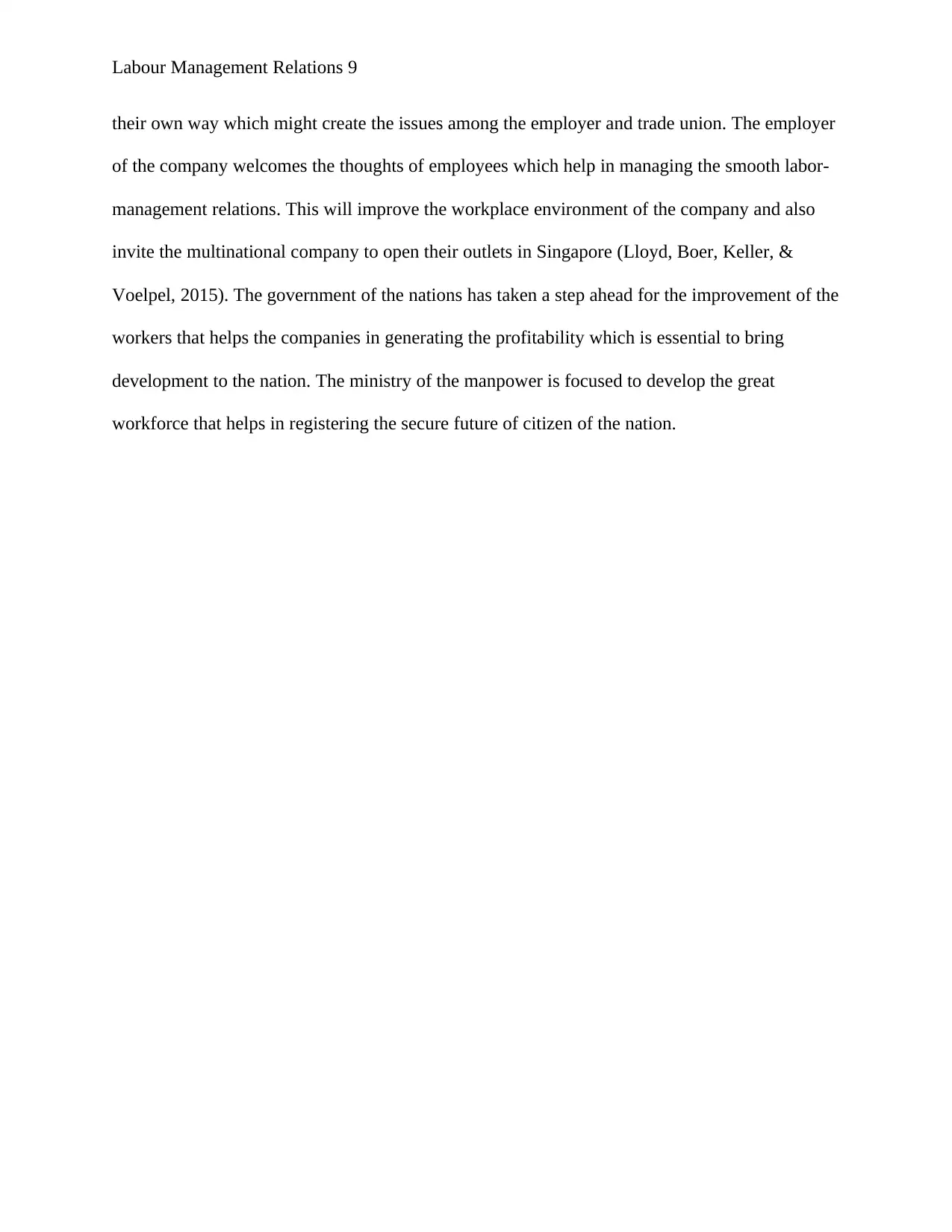
Labour Management Relations 9
their own way which might create the issues among the employer and trade union. The employer
of the company welcomes the thoughts of employees which help in managing the smooth labor-
management relations. This will improve the workplace environment of the company and also
invite the multinational company to open their outlets in Singapore (Lloyd, Boer, Keller, &
Voelpel, 2015). The government of the nations has taken a step ahead for the improvement of the
workers that helps the companies in generating the profitability which is essential to bring
development to the nation. The ministry of the manpower is focused to develop the great
workforce that helps in registering the secure future of citizen of the nation.
their own way which might create the issues among the employer and trade union. The employer
of the company welcomes the thoughts of employees which help in managing the smooth labor-
management relations. This will improve the workplace environment of the company and also
invite the multinational company to open their outlets in Singapore (Lloyd, Boer, Keller, &
Voelpel, 2015). The government of the nations has taken a step ahead for the improvement of the
workers that helps the companies in generating the profitability which is essential to bring
development to the nation. The ministry of the manpower is focused to develop the great
workforce that helps in registering the secure future of citizen of the nation.
Paraphrase This Document
Need a fresh take? Get an instant paraphrase of this document with our AI Paraphraser
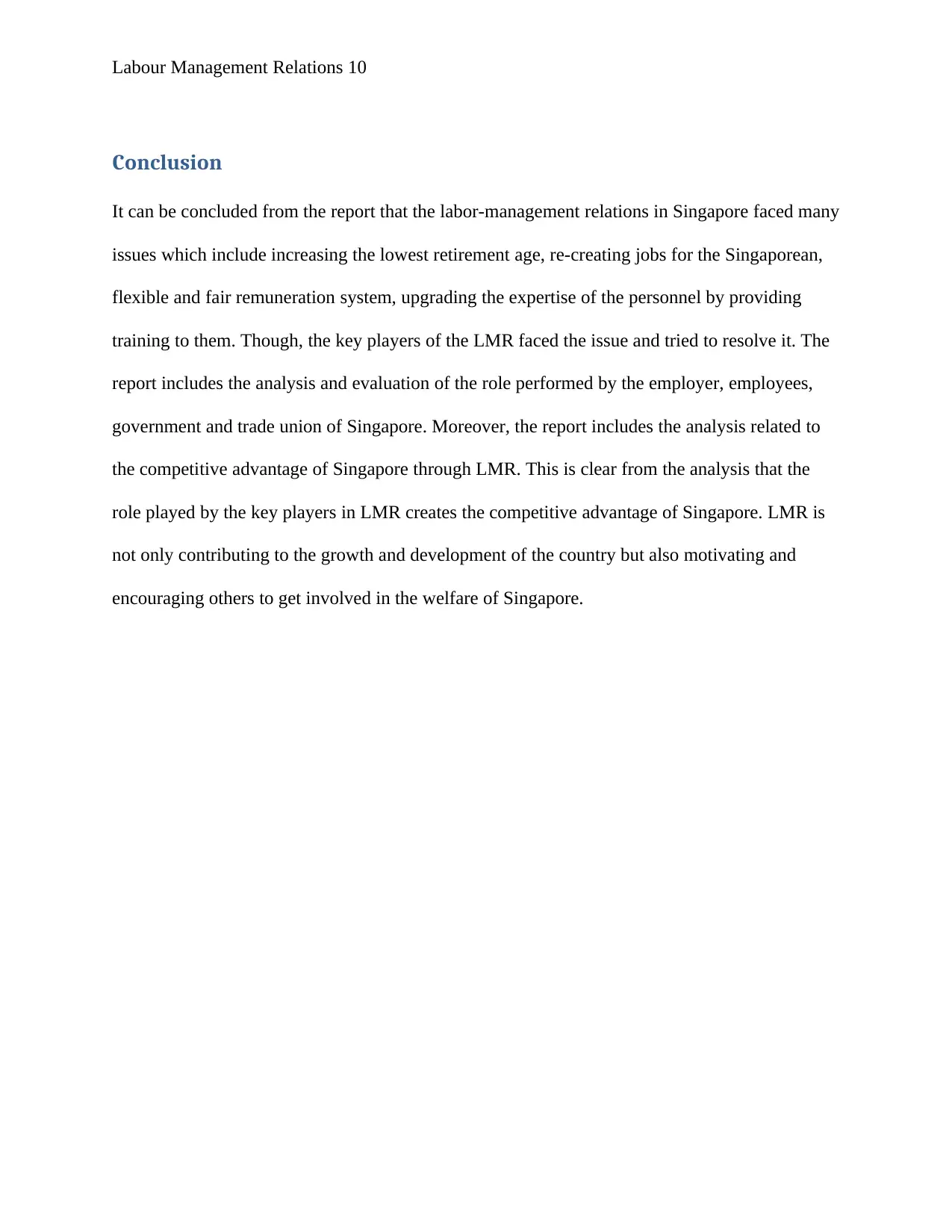
Labour Management Relations 10
Conclusion
It can be concluded from the report that the labor-management relations in Singapore faced many
issues which include increasing the lowest retirement age, re-creating jobs for the Singaporean,
flexible and fair remuneration system, upgrading the expertise of the personnel by providing
training to them. Though, the key players of the LMR faced the issue and tried to resolve it. The
report includes the analysis and evaluation of the role performed by the employer, employees,
government and trade union of Singapore. Moreover, the report includes the analysis related to
the competitive advantage of Singapore through LMR. This is clear from the analysis that the
role played by the key players in LMR creates the competitive advantage of Singapore. LMR is
not only contributing to the growth and development of the country but also motivating and
encouraging others to get involved in the welfare of Singapore.
Conclusion
It can be concluded from the report that the labor-management relations in Singapore faced many
issues which include increasing the lowest retirement age, re-creating jobs for the Singaporean,
flexible and fair remuneration system, upgrading the expertise of the personnel by providing
training to them. Though, the key players of the LMR faced the issue and tried to resolve it. The
report includes the analysis and evaluation of the role performed by the employer, employees,
government and trade union of Singapore. Moreover, the report includes the analysis related to
the competitive advantage of Singapore through LMR. This is clear from the analysis that the
role played by the key players in LMR creates the competitive advantage of Singapore. LMR is
not only contributing to the growth and development of the country but also motivating and
encouraging others to get involved in the welfare of Singapore.
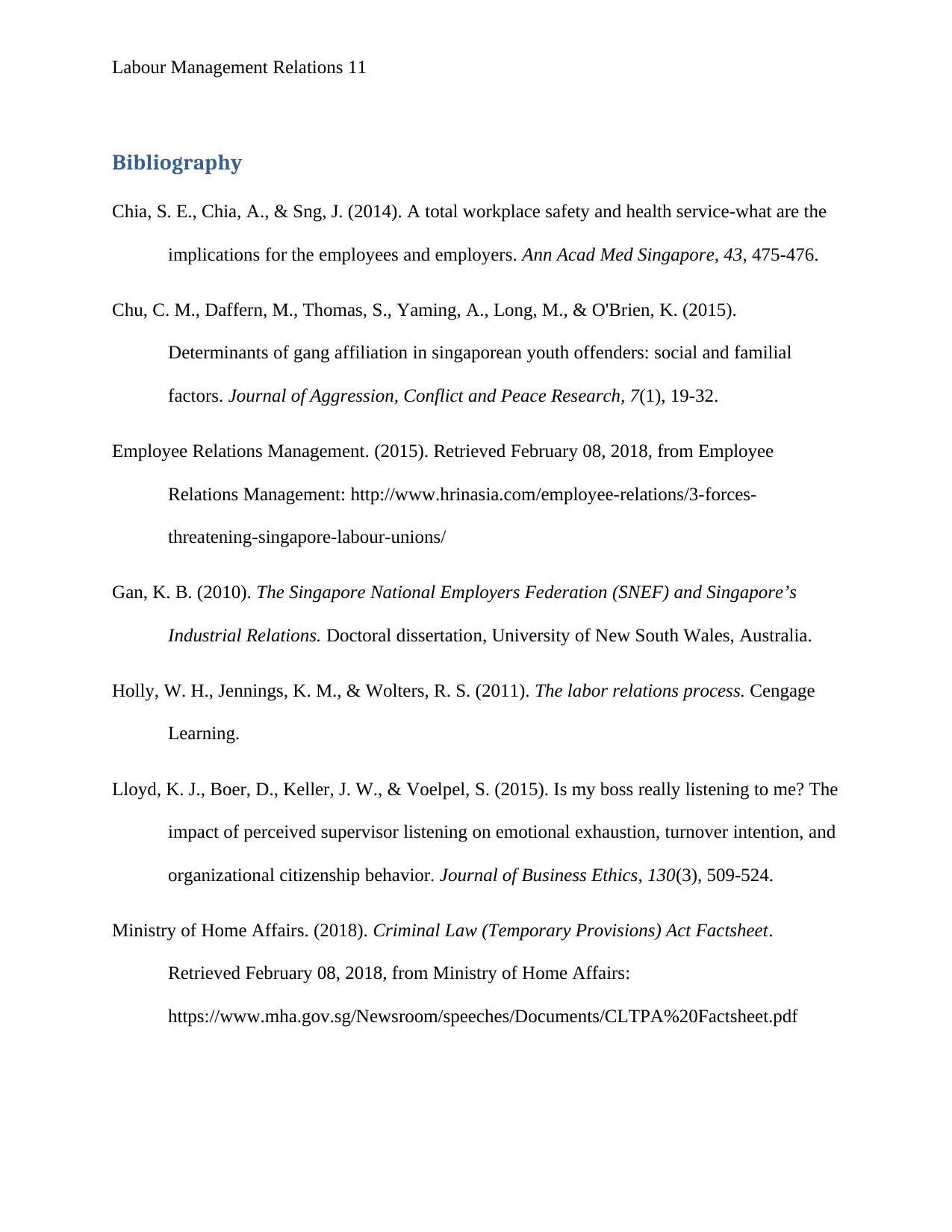
Labour Management Relations 11
Bibliography
Chia, S. E., Chia, A., & Sng, J. (2014). A total workplace safety and health service-what are the
implications for the employees and employers. Ann Acad Med Singapore, 43, 475-476.
Chu, C. M., Daffern, M., Thomas, S., Yaming, A., Long, M., & O'Brien, K. (2015).
Determinants of gang affiliation in singaporean youth offenders: social and familial
factors. Journal of Aggression, Conflict and Peace Research, 7(1), 19-32.
Employee Relations Management. (2015). Retrieved February 08, 2018, from Employee
Relations Management: http://www.hrinasia.com/employee-relations/3-forces-
threatening-singapore-labour-unions/
Gan, K. B. (2010). The Singapore National Employers Federation (SNEF) and Singapore’s
Industrial Relations. Doctoral dissertation, University of New South Wales, Australia.
Holly, W. H., Jennings, K. M., & Wolters, R. S. (2011). The labor relations process. Cengage
Learning.
Lloyd, K. J., Boer, D., Keller, J. W., & Voelpel, S. (2015). Is my boss really listening to me? The
impact of perceived supervisor listening on emotional exhaustion, turnover intention, and
organizational citizenship behavior. Journal of Business Ethics, 130(3), 509-524.
Ministry of Home Affairs. (2018). Criminal Law (Temporary Provisions) Act Factsheet.
Retrieved February 08, 2018, from Ministry of Home Affairs:
https://www.mha.gov.sg/Newsroom/speeches/Documents/CLTPA%20Factsheet.pdf
Bibliography
Chia, S. E., Chia, A., & Sng, J. (2014). A total workplace safety and health service-what are the
implications for the employees and employers. Ann Acad Med Singapore, 43, 475-476.
Chu, C. M., Daffern, M., Thomas, S., Yaming, A., Long, M., & O'Brien, K. (2015).
Determinants of gang affiliation in singaporean youth offenders: social and familial
factors. Journal of Aggression, Conflict and Peace Research, 7(1), 19-32.
Employee Relations Management. (2015). Retrieved February 08, 2018, from Employee
Relations Management: http://www.hrinasia.com/employee-relations/3-forces-
threatening-singapore-labour-unions/
Gan, K. B. (2010). The Singapore National Employers Federation (SNEF) and Singapore’s
Industrial Relations. Doctoral dissertation, University of New South Wales, Australia.
Holly, W. H., Jennings, K. M., & Wolters, R. S. (2011). The labor relations process. Cengage
Learning.
Lloyd, K. J., Boer, D., Keller, J. W., & Voelpel, S. (2015). Is my boss really listening to me? The
impact of perceived supervisor listening on emotional exhaustion, turnover intention, and
organizational citizenship behavior. Journal of Business Ethics, 130(3), 509-524.
Ministry of Home Affairs. (2018). Criminal Law (Temporary Provisions) Act Factsheet.
Retrieved February 08, 2018, from Ministry of Home Affairs:
https://www.mha.gov.sg/Newsroom/speeches/Documents/CLTPA%20Factsheet.pdf
⊘ This is a preview!⊘
Do you want full access?
Subscribe today to unlock all pages.

Trusted by 1+ million students worldwide
1 out of 14
Related Documents
Your All-in-One AI-Powered Toolkit for Academic Success.
+13062052269
info@desklib.com
Available 24*7 on WhatsApp / Email
![[object Object]](/_next/static/media/star-bottom.7253800d.svg)
Unlock your academic potential
Copyright © 2020–2025 A2Z Services. All Rights Reserved. Developed and managed by ZUCOL.





